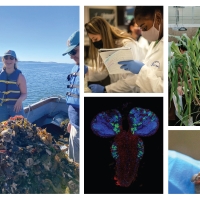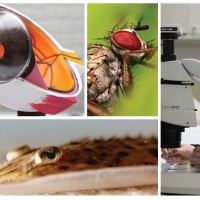Biology, Math faculty win prestigious early-career awards

Three researchers received NSF funding in support of their research efforts and commitment to STEM education
The National Science Foundation has awarded Early CAREER grants to three San Francisco State University researchers. Assistant Professors of Biology Rori Rohlfs and Alejandro Vélez Meléndez and Assistant Professor of Mathematics Emily Clader are the latest in a long line of San Francisco State honorees. University faculty have earned 21 awards since 1996, placing SF State second in CAREER awards in the California State University system.
The new grants will support research on frog communication, the evolution of biological traits and the intersection of two math fields. All of this year’s awardees also have ambitious goals to expand research and educational opportunities for students and the local community.
Rori Rohlfs: The role of DNA tandem repeats in great ape evolution
Variations in repeating sequences of DNA (aka tandem repeats) lead to some of the differences we see among individuals and may contribute to the rapid trait evolution observed between closely related species like chimpanzees and humans. Unfortunately, tandem repeats have been difficult to study, and although sequencing technology has advanced, tools to analyze the resulting data are still lacking.
Rohlfs' project aims to fix that. She’s proposed developing a statistical tool called TREVA (Tandem Repeat Evolutionary Variance Analysis). Using TREVA to analyze sequencing data, she hopes to identify tandem repeats involved in adaption in primates and discover the underlying biological processes and traits under selection in great apes. Since tandem repeats can distinguish individuals, this project also has implications for forensic genetics, a major focus in Rohlfs’ lab.
"So many clues suggest that tandem repeat variation may underlie rapid evolution,” she explained. “I’m excited to develop methods to finally test the tandem repeat adaptive hypotheses directly.”
But beyond the research, Rohlfs is excited about how this award will help her students. The tandem repeat research will be largely done by undergraduate and master’s students. She plans to share their work in video abstracts that feature the PEER and PEG (Persons Excluded because of Ethnicity or Race, and Persons Excluded because of Gender) researchers on the project. In addition, Rohlfs is designing a computational research summer program to teach novice undergraduates about computer programming and how to apply it to research.
Alejandro Vélez Meléndez: The effect of noise pollution on frog communication
In the Bay Area, there is a lot of human-generated noise pollution that affects local wildlife. Many studies have focused on how these environmental stressors can cause animals to change their vocalizations, but Vélez points out that communication is an activity that involves two animals.
“Nobody has really looked at the hearing side of the receivers,” he explained. “How are they coping with this problem?”
To evaluate how noise pollution is affecting auditory processing, Vélez's project is focusing on Pacific Chorus frogs, which are widely found in the Bay Area. Along with comparing the behavioral differences of frogs across the Bay, he’ll evaluate the anatomical and physiological modifications that underlie these observations. His project has proposed an integrative approach, studying animals both in the lab and in nature across the Bay Area at sites such as San Francisco International Airport, Point Reyes and locations in the East Bay.
Displays at the various sites will offer information about noise pollution and help engage the passersby and community members in the research, he explained. By getting the public to listen to the sound of frogs and birds versus human-generated noise, he hopes that people will appreciate the silence and how noise is really affecting everything. Closer to home, the new grant will support development of a new University course in sensory ecology.
Emily Clader: Bridging algebraic geometry and combinatorics
Curves are one of the most fundamental — and therefore relatively well-studied — objects in the field of algebraic geometry. Clader is excited that her project will study a new parameter that can describe both marked curves and a geometric object called the permutahedron.
The permutahedron has flat sides and vertices that can be labelled with permutations. This object excites mathematicians because it can reveal difficult-to-detect combinatorial information about permutations. However, the permutahedron’s vertices can also be labelled by marked curves, explained Clader. This means that the permutahedron can be used to bridge algebraic geometry and combinatorics — two fields of math that are strong at SF State. Clader and her collaborators want to better study this intersection and understand this new parameter, especially because the marked curves-permutahedron story may be one example in a larger family involving this parameter.
Clader is also eager to use the CAREER award to help her expand student research opportunities, something that is invaluable for students hoping to pursue math research. “Algebraic geometry tends to be viewed as something that has a lot of prerequisites that a lot of students — myself included — are not exposed to until maybe a year or two into their Ph.D. program,” she explained. That’s why she’s developing a math textbook for early-stage mathematicians. She hopes it will help give undergraduate and master’s students the foundation they need to get involved in math research that has often been out of reach.



